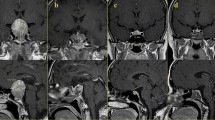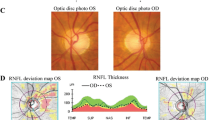Abstract
Purpose
Although optical coherence tomography (OCT) of the eyes has been studied to detect and monitor sellar masses, there is no recommendation for selecting the most effective measurement of OCT in clinical practice. Thus, we conducted a meta-analysis to examine the efficacy of OCT in sellar mass lesions.
Methods
We conducted a literature search in PubMed and EMBASE through April 26, 2020. The primary outcomes were the thickness of the peripapillary retinal nerve fiber layer (pRNFL) and the macular ganglion cell complex (mGCC). The secondary outcomes included the thickness of the macular ganglion cell and inner plexiform layer (mGCIPL) and macular thickness. Random-effects models were used in all meta-analyses. Additionally, we conducted meta-regressions and subgroup analyses.
Results
We included 22 studies, involving 1347 eyes of patients and 1198 eyes of controls. When compared with the control group, the reductions in pRNFL, mGCC and macular thickness in the patient group were significantly different, whereas significant thinning of the mGCIPL was restricted to the nasal hemiretina. Furthermore, we found that before visual field (VF) defects occurred, significant thinning of the pRNFL and mGCC thickness could be detected by OCT. The change in OCT parameters also showed different patterns in different types of pituitary adenomas.
Conclusions
Sellar mass lesions were associated with the changes in OCT measurements. The characteristic patterns of the OCT parameters may refine the diagnostic accuracy. Moreover, the alterations of OCT metrics before VF defects indicate the efficacy of OCT in early detection. Different types of pituitary adenomas may vary in OCT measurements, and their specific features warrant further research efforts.

Similar content being viewed by others
Data availability
All data relevant to the study are included in the article or uploaded as online supplementary information.
References
Bresson D, Herman P, Polivka M, Froelich S (2016) Sellar lesions/pathology. Otolaryngol Clin N Am 49:63–93. https://doi.org/10.1016/j.otc.2015.09.004
Danesh-Meyer HV, Yoon JJ, Lawlor M, Savino PJ (2019) Visual loss and recovery in chiasmal compression. Prog Retin Eye Res 73:100765. https://doi.org/10.1016/j.preteyeres.2019.06.001
Molitch ME (2017) Diagnosis and treatment of pituitary adenomas: a review. JAMA 317:516–524. https://doi.org/10.1001/jama.2016.19699
Blanch RJ, Micieli JA, Oyesiku NM, Newman NJ, Biousse V (2018) Optical coherence tomography retinal ganglion cell complex analysis for the detection of early chiasmal compression. Pituitary 21:515–523. https://doi.org/10.1007/s11102-018-0906-2
Jeon C, Park KA, Hong SD, Choi JW, Seol HJ, Nam DH, Lee JI, Shin HJ, Kong DS (2019) Clinical efficacy of optical coherence tomography to predict the visual outcome after endoscopic endonasal surgery for suprasellar tumors. World Neurosurg 132:e722–e731. https://doi.org/10.1016/j.wneu.2019.08.031
Danesh-Meyer HV, Wong A, Papchenko T, Matheos K, Stylli S, Nichols A, Frampton C, Daniell M, Savino PJ, Kaye AH (2015) Optical coherence tomography predicts visual outcome for pituitary tumors. J Clin Neurosci 22:1098–1104. https://doi.org/10.1016/j.jocn.2015.02.001
Al-Louzi O, Prasad S, Mallery RM (2018) Utility of optical coherence tomography in the evaluation of sellar and parasellar mass lesions. Curr Opin Endocrinol Diabetes Obes 25:274–284. https://doi.org/10.1097/MED.0000000000000415
Danesh-Meyer HV, Carroll SC, Foroozan R, Savino PJ, Fan J, Jiang Y, Vander Hoorn S (2006) Relationship between retinal nerve fiber layer and visual field sensitivity as measured by optical coherence tomography in chiasmal compression. Investig Ophthalmol Vis Sci 47:4827–4835. https://doi.org/10.1167/iovs.06-0327
Stroup DF, Berlin JA, Morton SC, Olkin I, Williamson GD, Rennie D, Moher D, Becker BJ, Sipe TA, Thacker SB (2000) Meta-analysis of observational studies in epidemiology: a proposal for reporting. Meta-analysis of observational studies in epidemiology (MOOSE) group. JAMA 283:2008–2012. https://doi.org/10.1001/jama.283.15.2008
Rostom A, Dubé C, Cranney A et al (2004) Celiac disease. Rockville (MD): agency for healthcare research and quality (US); 2004 (Evidence reports/technology assessments, No. 104.) Appendix D. Quality assessment forms. https://www.ncbi.nlm.nih.gov/books/NBK35156/. Accessed 30 Apr 2020
Yang L, Qu Y, Lu W, Liu F (2016) Evaluation of macular ganglion cell complex and peripapillary retinal nerve fiber layer in primary craniopharyngioma by fourier-domain optical coherence tomography. Med Sci Monit 22:2309–2314. https://doi.org/10.12659/msm.896221
Monteiro ML, Cunha LP, Vessani RM (2008) Comparison of retinal nerve fiber layer measurements using Stratus OCT fast and regular scan protocols in eyes with band atrophy of the optic nerve and normal controls. Arq Bras Oftalmol 71:534–539. https://doi.org/10.1590/s0004-27492008000400013
Monteiro ML, Cunha LP, Costa-Cunha LV, Maia OJ, Oyamada MK (2009) Relationship between optical coherence tomography, pattern electroretinogram and automated perimetry in eyes with temporal hemianopia from chiasmal compression. Investig Ophthalmol Vis Sci 50:3535–3541. https://doi.org/10.1167/iovs.08-3093
Zhang X, Ma J, Wang YH, Gan LY, Li L, Wang XQ, Li DH, Xing B, Feng M, Zhu HJ, Lu L, Feng F, You H, Zhang ZH, Zhong Y (2019) the correlation of ganglion cell layer thickness with visual field defect in non-functional pituitary adenoma with chiasm compression. Zhonghua Yan Ke Za Zhi 55:186–194. https://doi.org/10.3760/cma.j.issn.0412-4081.2019.03.007
Duru N, Ersoy R, Altinkaynak H, Duru Z, Cagil N, Cakir B (2016) Evaluation of retinal nerve fiber layer thickness in acromegalic patients using spectral-domain optical coherence tomography. Semin Ophthalmol 31:285–290. https://doi.org/10.3109/08820538.2014.962165
Yum HR, Park SH, Park HY, Shin SY (2016) Macular ganglion cell analysis determined by cirrus HD optical coherence tomography for early detecting chiasmal compression. PLoS ONE 11:e153064. https://doi.org/10.1371/journal.pone.0153064
Tang Y, Qu YZ, Yang L, Wang J, Wang LN, Fang M, Lu W (2012) Assessing the damage to visual function by optical coherence tomography and the visual field test in Saddle area tumor patients. Zhonghua Yan Ke Za Zhi 48:1001–1004
Ohkubo S, Higashide T, Takeda H, Murotani E, Hayashi Y, Sugiyama K (2012) Relationship between macular ganglion cell complex parameters and visual field parameters after tumor resection in chiasmal compression. Jpn J Ophthalmol 56:68–75. https://doi.org/10.1007/s10384-011-0093-4
Moon CH, Hwang SC, Kim BT, Ohn YH, Park TK (2011) Visual prognostic value of optical coherence tomography and photopic negative response in chiasmal compression. Investig Ophthalmol Vis Sci 52:8527–8533. https://doi.org/10.1167/iovs.11-8034
Costa-Cunha LV, Cunha LP, Malta RF, Monteiro ML (2009) Comparison of Fourier-domain and time-domain optical coherence tomography in the detection of band atrophy of the optic nerve. Am J Ophthalmol 147:56–63. https://doi.org/10.1016/j.ajo.2008.07.020
Jacob M, Raverot G, Jouanneau E, Borson-Chazot F, Perrin G, Rabilloud M, Tilikete C, Bernard M, Vighetto A (2009) Predicting visual outcome after treatment of pituitary adenomas with optical coherence tomography. Am J Ophthalmol 147:64–70. https://doi.org/10.1016/j.ajo.2008.07.016
Monteiro ML, Leal BC, Rosa AA, Bronstein MD (2004) Optical coherence tomography analysis of axonal loss in band atrophy of the optic nerve. Br J Ophthalmol 88:896–899. https://doi.org/10.1136/bjo.2003.038489
Cennamo G, Auriemma RS, Cardone D, Grasso LF, Velotti N, Simeoli C, Di Somma C, Pivonello R, Colao A, de Crecchio G (2015) Evaluation of the retinal nerve fibre layer and ganglion cell complex thickness in pituitary macroadenomas without optic chiasmal compression. Eye (Lond) 29:797–802. https://doi.org/10.1038/eye.2015.35
Tieger MG, Hedges TR, Ho J, Erlich-Malona NK, Vuong LN, Athappilly GK, Mendoza-Santiesteban CE (2017) Ganglion cell complex loss in chiasmal compression by brain tumors. J Neuroophthalmol 37:7–12. https://doi.org/10.1097/WNO.0000000000000424
Sahin M, Sahin A, Kilinc F, Yuksel H, Ozkurt ZG, Turkcu FM, Pekkolay Z, Soylu H, Caca I (2017) Retina ganglion cell/inner plexiform layer and peripapillary nerve fiber layer thickness in patients with acromegaly. Int Ophthalmol 37:591–598. https://doi.org/10.1007/s10792-016-0310-8
Pekel G, Akin F, Erturk MS, Acer S, Yagci R, Hiraali MC, Cetin EN (2014) Chorio-retinal thickness measurements in patients with acromegaly. Eye (Lond) 28:1350–1354. https://doi.org/10.1038/eye.2014.216
Nakamura M, Ishikawa-Tabuchi K, Kanamori A, Yamada Y, Negi A (2012) Better performance of RTVue than Cirrus spectral-domain optical coherence tomography in detecting band atrophy of the optic nerve. Graefes Arch Clin Exp Ophthalmol 250:1499–1507. https://doi.org/10.1007/s00417-012-2095-4
Moura FC, Medeiros FA, Monteiro ML (2007) Evaluation of macular thickness measurements for detection of band atrophy of the optic nerve using optical coherence tomography. Ophthalmology 114:175–181. https://doi.org/10.1016/j.ophtha.2006.06.045
Sun M, Zhang Z, Ma C, Chen S, Chen X (2017) Quantitative analysis of retinal layers on three-dimensional spectral-domain optical coherence tomography for pituitary adenoma. PLoS ONE 12:e179532. https://doi.org/10.1371/journal.pone.0179532
Monteiro ML, Hokazono K, Fernandes DB, Costa-Cunha LV, Sousa RM, Raza AS, Wang DL, Hood DC (2014) Evaluation of inner retinal layers in eyes with temporal hemianopic visual loss from chiasmal compression using optical coherence tomography. Investig Ophthalmol Vis Sci 55:3328–3336. https://doi.org/10.1167/iovs.14-14118
Sousa RM, Oyamada MK, Cunha LP, Monteiro M (2017) Multifocal visual evoked potential in eyes with temporal hemianopia from chiasmal compression: correlation with standard automatecd perimetry and OCT findings. Investig Ophthalmol Vis Sci 58:4436–4449. https://doi.org/10.1167/iovs.17-21529
Moura FC, Costa-Cunha LV, Malta RF, Monteiro ML (2010) Relationship between visual field sensitivity loss and quadrantic macular thickness measured with Stratus-Optical coherence tomography in patients with chiasmal syndrome. Arq Bras Oftalmol 73:409–413. https://doi.org/10.1590/s0004-27492010000500004
Akashi A, Kanamori A, Ueda K, Matsumoto Y, Yamada Y, Nakamura M (2014) The detection of macular analysis by SD-OCT for optic chiasmal compression neuropathy and nasotemporal overlap. Investig Ophthalmol Vis Sci 55:4667–4672. https://doi.org/10.1167/iovs.14-14766
Jeong AR, Kim EY, Kim NR (2016) Preferential ganglion cell loss in the nasal hemiretina in patients with pituitary tumor. J Neuroophthalmol 36:152–155. https://doi.org/10.1097/WNO.0000000000000331
Lee J, Kim SW, Kim DW, Shin JY, Choi M, Oh MC, Kim SM, Kim EH, Kim SH, Byeon SH (2016) Predictive model for recovery of visual field after surgery of pituitary adenoma. J Neurooncol 130:155–164. https://doi.org/10.1007/s11060-016-2227-5
Rogers A, Karavitaki N, Wass JA (2014) Diagnosis and management of prolactinomas and non-functioning pituitary adenomas. BMJ 349:g5390. https://doi.org/10.1136/bmj.g5390
Fleming T, Balderas-Márquez JE, Epardo D, Ávila-Mendoza J, Carranza M, Luna M, Harvey S, Arámburo C, Martínez-Moreno CG (2019) Growth hormone neuroprotection against kainate excitotoxicity in the retina is mediated by Notch/PTEN/Akt signaling. Investig Ophthalmol Vis Sci 60:4532–4547. https://doi.org/10.1167/iovs.19-27473
Funding
No funding was received for this research.
Author information
Authors and Affiliations
Contributions
Conceptualization: YZ and YC; Methodology: JM and YC; Data collection and analysis: BZ and LG; Writing-original draft preparation: YC; Review and editing: all authors; Supervision: YZ. All authors read and approved the final manuscript.
Corresponding author
Ethics declarations
Conflict of interests
The authors declare that they have no conflicts of interest.
Ethical approval
This is a meta-analysis based on observational studies.
Informed consent
Informed consent from patients and ethical approval for this type of study are not required.
Additional information
Publisher's Note
Springer Nature remains neutral with regard to jurisdictional claims in published maps and institutional affiliations.
Electronic supplementary material
Below is the link to the electronic supplementary material.
Rights and permissions
About this article
Cite this article
Chou, Y., Zhang, B., Gan, L. et al. Clinical efficacy of optical coherence tomography in sellar mass lesions: a meta-analysis. Pituitary 23, 733–744 (2020). https://doi.org/10.1007/s11102-020-01072-w
Published:
Issue Date:
DOI: https://doi.org/10.1007/s11102-020-01072-w




